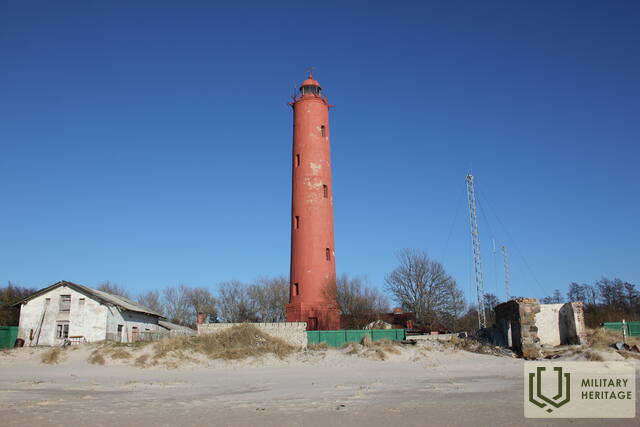Akmeņrags Lighthouse and the fate of the "Saratov"
Infrastructure

The Akmeņrags Lighthouse is located in Saka parish, 10 kilometres southwest of Pāvilosta. The top of the lighthouse can be reached by a spiral staircase and it offers views of the sea and the surrounding forests. Standing at 37 metres high, the current lighthouse tower was built in 1921, while the previous lighthouse was destroyed during World War I.
The Akmeņrags Lighthouse stands out among other lighthouses in Latvia, as it is located in one of the most dangerous places for sailing in the entire Baltic Sea coast. The signal beam of the lighthouse marks a rocky bank, which extends approximately two nautical miles or 3.7 kilometres into the sea in a north-western direction. The depth of the bank is just over two metres. The location of the lighthouse has remained unchanged, but the coastline has been receding over the years. Although a navigation light has been here since 1879, Akmeņrags has seen several shipwrecks. The most notable occurred in September 1923 when a Latvian steamer named Saratow struck the ground. In 1919, Saratow briefly served as the seat of the Latvian Provisional Government. Akmeņrags used to be home to a border guard post, and buildings of the Soviet Army are can be viewed here.
Used sources and references:
Lighthouses - Ventspils Freeport Authority (portofventspils.lv)
https://www.latvia.travel/lv/apskates-vieta/akmenraga-baka
Educational programs
Excursion to Akmenrag lighthouse
It is possible to climb the Akmeņraga lighthouse via a spiral staircase. Climbing the lighthouse offers a fantastic view of the sea and surrounding forests. The lighthouse is the main ornament of Akmeņraga. In 2011, during the implementation of the project, the road to the Akmeņraga lighthouse was reconstructed. Far beyond the borders of Akmeņraga, information has spread about the unique collection of amber and stones collected by the lighthouse keeper.
Related timeline
Related stories
Forbidden Lighthouses and Seashore
During the USSR era, the seacoast in North and West Kurzeme were actually military zones closed to the public, but it was forbidden to visit the lighthouses or even take photographs
“PZ" - border zone
Memories of Andris Zaļkalns, chairman of the Vērgale village council of people's deputies (1982-1989), about life in the border zone.
Akmeņrags Lighthouse and Shoal - one of the largest ship graveyards in the Baltic Sea
It was in the Akmensrags lighthouse area that, on January 13, 1923, the steamer Saratov , on which the provisional government led by K. Ulmanis took refuge when the independent state of Latvia was established, tragically ran aground and crashed.
Akmenrags Military Complex
There was a military complex in Akmeņrags during the Soviet era.
Artūrs Ozols' memories of the ship "Saratov"
Artūrs Ozols graduated from Riga Polytechnic and served as a naval officer (midshipman) and engineer in the Russian Black Sea Fleet aboard the warship Panteleimon. During the Latvian Liberation Struggle, he joined the Student Company. In Liepaja he put the ship "Saratov" into service. Arthurs Ozols' memoirs about the ship "Saratov" were published in the Dauagava Vanagi monthly
Cape and the ship "Saratov"
It can be assumed that Liepaja was the capital of Latvia for a short period of time, because during the Freedom Struggle the Provisional Government was stationed on the ship Saratov in this very city. The Saratov took the Provisional Government to Riga after its liberation, but many people do not know that the history of such an important ship for us ended at sea at Akmenrags.
Kurzeme coast - closed area
During the Cold War, the entire Kurzeme coastline was a closed zone to the public - Soviet border guards were the main decision-makers here, with guard posts at certain distances and observation towers with spotlight stations on the beach. Civilians were only allowed on the seafront during daylight hours.
"The Latvian SSR NPP will be here!"
Memories of Andris Zaļkalns (born 1951, Chairman of the Council of People's Deputies of the village of Vērgale (1982-1989)) about the time when a nuclear power plant was almost built in Akmeņrags.
Latvian Army armored train No. 5 or "Kolpaks"
Latvian Army Armoured Train No.5 or "Kalpaks" was a light armoured train in the Latvian Armed Forces in 1919.




























